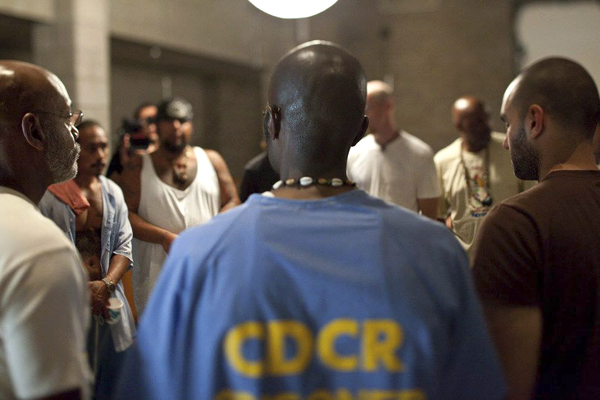Most films centered on convicts tend to be preoccupied with their legal guilt or innocence, but that’s not the case with this intense documentary, which is more concerned with their emotional states. It takes viewers into California’s Folsom State Prison to observe group therapy sessions attended by prisoners, a program that has been going on for the past 17 years with positive results. As a title card informs us, more than 40 convicts who took part have been released on parole, and of that number, none has ever returned to jail.
The basis of The Work is that twice a year, the public can attend these sessions for four full days. The film’s initial shots are of the yard outside the prison complex, where convicts segregate themselves based on ethnicity. These give way to a sparse, cavernous facility where any such divisions disappear, and the end goal is the dissolving of all walls, mental or emotional.
The cameras follow a trio of visitors into this stark world, and after a facilitator offers some initial remarks about the “journey” they will be taking, each chooses two convicts to act as his guide. During this initial period, we get to know what brings the outsiders to Folsom and are also introduced to some of the prisoners. The most memorable of which include a Native American named Dark Cloud, who claims he was locked up for trying to cut a man in half, and Vegas, a former member of the notorious Bloods gang, but who now radiates gentleness and wisdom.
The maximum-security prison holds murderers, kidnappers, and other violent offenders. They might seem like the last men to get in touch with their feelings, and indeed, the first inmate on camera to “get into it,” as the process is referred to, expresses a fear of doing so. Being dead on the inside is, understandably, key to his survival in this place, but now he wants to properly grieve for his recently-deceased sister.
Vegas engages with him in one-on-one conversation, drawing closer to him inside a slowly collapsing circle of other participants. Never breaking eye contact, he talks the other man into digging increasingly deeper into the source of his pain, which builds up inside the latter until he explodes into tears, a violent torrent sadness so overwhelming that several of the convicts must hold him down until he’s done letting everything out.
Across the four days, this pattern unfolds repeatedly, and the steps by which prisoners and civilians alike tear down their emotional barriers is prolonged, suspenseful, and nothing short of riveting. It also seems to come easier for the convicts, and much of the suspense is over whether the visitors will have their own breakthroughs. Charles, a bartender, looks to resolve an irrational fear of prison, which might stem from his own father being a convict. Meanwhile, Chris, who’s in his mid-20s and seemingly the most innocuous of the three, has come in hopes of finding direction. By committing to spending four days in the program, he hopes to take the first step in committing to other things.
But easily the most interesting, and potentially problematic of the trio, is Brian, a teaching assistant who has an arrogant smile and tendency to quickly judge others. The filmmakers catch two of the convicts watching him at a distance, commenting how they see much of themselves in him. Before long, Brian talks himself into trouble with one of the convicts; the confrontation ends with him swelling up with rage himself. During this sequence, as with all the others like it, the camera stays focused on the participants, and while the shots aren’t unbroken, they are edited to feel as if occurring in real time.
Without question, the men look inward in the most powerful scenes and come face-to-face with the darkness they find. However, it’s the moments afterwards, when they hug, pay compliments to one another, or otherwise show love and appreciation that are unexpectedly powerful and uplifting. The toughest-looking men break down into tears, such as when a convict named Dante, a former gang member serving a life sentence plus 55 years, mentions the despair he is in, because his partner will not bring his son to visit him. Even the veteran participants are unsure of how to save him. It also reinforces the reality of who these men are: prisoners who may not be see the outside world again for a long time.
These descriptions of men getting in touch with their emotions might make The Work sound earnest and New Age-y, but the film is anything but that. On the contrary, the director constantly reminds us that we are in a prison, a place where convicted criminals have been left behind to rot. Most of the soundtrack consists of screaming and crying in the background. In addition, we are constantly reminded that although these convicts are doing important work to improve themselves, they still have the capacity to react violently and threateningly, even when there was no intent to offend them.
This film keeps the viewer on edge and is also deeply moving. It reminds us that we all have the capacity to change for the better, no matter who we are, as long as we’re willing to put in the work.

















Leave A Comment